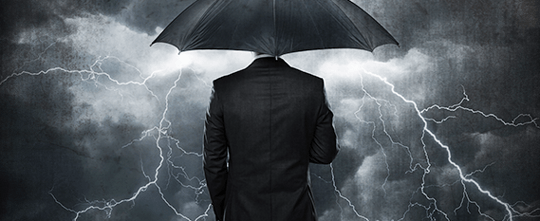The Lull Before the Storm?
We’ve been scratching our noggin lately over the calm — the eerie calm — that’s descended upon markets.
A rate hike this Wednesday is a dead cinch. More hikes are in prospect later this year. The debt ceiling expires this Wednesday, with high odds of a budget crisis (see below).
As the Daily Reckoning’s International Man, Simon Black tells us this morning the government’s cash hoard is down to just $34 billion. It’ll be out of cash by Memorial Day if the ceiling isn’t raised.
To these possible head winds we add roiling tensions in Asia and critical elections in Europe.
But the VIX index, Wall Street’s “fear gauge,” is down again today…
Worry not, says the market. It’s safe out there. Come… cast your bread upon the waters.
But what’s this we see? Weather ahead? Details in a moment.
But first the latest report…
The Dow’s off 22 points today, the S&P’s just about flat.
Meanwhile, crude lost a nickel, and gold — a barometer of sorts — is up about three bucks.
A quiet day overall. Too quiet.
But it’s something else that’s got us pulling in our sails today…
The Wall Street Journal reports that insider buying — company brass buying its own stock — is at its lowest level in 29 years:
Corporate executives are buying their own firms’ shares at the slowest pace in at least 29 years, the latest sign of uncertainty as the bull market in U.S. stocks enters its ninth year… There were a total of 279 insider buyers in January, the lowest number going back to 1988, according to the Washington Service, a provider of insider-trading data and analytics.
Many consider insider action a leading market indicator. It’s a good sign if the insiders are buying. It’s a bad sign if they’re selling.
After all, who knows a company’s prospects better than the insiders? Theirs is the “smart money.”
And now the smart money’s selling… just as the fools are rushing in.
Maybe the insiders know something the fools don’t?
The Journal offers a clue:
While many investors expect corporate earnings to pick up in coming quarters, reflecting the continuing U.S. economic recovery and Trump administration tax cut and deregulatory plans, the strong market gains mean that investors are paying more now for expected corporate earnings than at any point in over a decade.
That’s the thing. Price/earnings (P/E) ratios are now firmly in what David Stockman calls the nosebleed level of history.
The average P/E ratio for the S&P is 26.6 — over 75% higher than its historical average.
Sovereign Man reports that since the 1870s, there have only been three other periods when the average P/E ratio broached 26.5.
The first preceded the Panic of 1893. The second came before the 2000 dot-com bust. The third preceded the crash of 2008.
So elevated were these P/E ratios… October ’29 doesn’t even crack the top three.
But at 26.6, today’s P/E ratio crosses the 26.5 red line — and is bleeding from the nose holes.
Sovereign Man: “Whenever financial markets get overheated, bad things tend to happen.”
You don’t say?
And despite the Fed’s cherry-picked unemployment data, it seems this “overheated market” finds little excuse in the facts…
GDP grew just 1.6% in 2016 — the 11th straight year under 3%.
Now the Atlanta Fed has slashed its projected first-quarter GDP growth from 1.8% to 1.3%. That same Atlanta Fed guessed 2.5% just two weeks ago. What will it be two weeks hence?
As analyst Jason Hamlin cheekily notes, “The disconnect between growth in equity valuations and growth in GDP is glaring.”
Glaring indeed. So this question: Where are those earnings going to come from to justify prices?
We have no answer either.
And if you lean contrarian, put this bullet in your chamber: Hamlin reports that the Consumer Comfort Index just crossed 50… for the first time since 2007.
That, says Hamlin, “is a contrarian indicator if I have ever seen one.”
In summary: We find insider buying at a 29-year low. P/E ratios in Stockman’s nosebleed section of history. The same P/E ratios that are glaringly disconnected from the latest GDP data. And we have a contrarian indicator flashing neon.
All this, stacked atop a looming debt crisis… rising interest rates… and geopolitical risks mounting by the day.
So… what could possibly go wrong?
Regards,
Brian Maher
Managing editor, The Daily Reckoning



Comments: